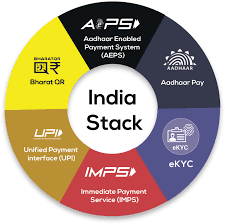Digital Public Infrastructure | 30 Mar 2023
For Prelims: Digital identity (Aadhar), Real-time fast payment (UPI) and Account Aggregator, DEPA.
For Mains: Digital Public Infrastructure.
Why in News?
Public infrastructure has been a cornerstone of human progress, but it has plagued the previous generation, making it imperative for the third type of public infrastructure called Digital Public Infrastructure (DPI), with more open and democratic principles built in it.
What is DPI?
- Digital public infrastructure (DPI) refers to blocks or platforms such as digital identification, payment infrastructure and data exchange solutions that help countries deliver essential services to their people, empowering citizens and improving lives by enabling digital inclusion.
- DPIs mediate the flow of people, money and information. First, the flow of people through a digital ID System. Second, the flow of money through a real-time fast payment system. And third, the flow of personal information through a consent-based data sharing system to actualize the benefits of DPIs and to empower the citizen with a real ability to control data.
- These three sets become the foundation for developing an effective DPI ecosystem.
- Each DPI layer fills a clear need and generates considerable value across sectors.
- India, through India Stack, became the first country to develop all three foundational DPIs, Digital identity (Aadhar), Real-time fast payment (UPI) and Account Aggregator built on the Data Empowerment Protection Architecture (DEPA).
- DEPA creates a digital framework that allows users to share their data on their own terms through a third-party entity, who are known as Consent Mangers.
What are the Pillars of India’s DPI Ecosystem?
- Aadhaar:
- Aadhaar is a strategic policy tool for social and financial inclusion, public sector delivery reforms, managing fiscal budgets, increasing convenience and promoting hassle-free people-centric governance.
- Aadhaar holders can voluntarily use their Aadhaar for private sector purposes, and private sector entities need not seek special permission for such usage.
- DigiYatra:
- DigiYatra is a Biometric Enabled Seamless Travel (BEST) experience based on a Facial Recognition System (FRS).
- Air passenger traffic in India was estimated to be over 188 million in airports across India in the financial year 2022, out of whom over 22 million were international passengers.
- DigiYatra is a Biometric Enabled Seamless Travel (BEST) experience based on a Facial Recognition System (FRS).
- DigiLocker:
- DigiLocker has 150 million users, six billion stored documents, and done with a tiny budget of RS 50 crore over seven years.
- The users can store their documents such as insurance, medical reports, PAN card, passport, marriage certificate, school certificate and other documents in the digital format.
- UPI:
- UPI (Unified Payment Interface) has crossed eight billion transactions per month and transacts a value of USD 180 billion a month, or about a staggering 65% of India’s GDP per annum.
- UPI is currently the biggest among the National Payments Corporation of India (NPCI) operated systems including National Automated Clearing House (NACH), Immediate Payment Service (IMPS), Aadhaar enabled Payment System (AePS), Bharat Bill Payment System (BBPS), RuPay etc.
What is India Stack?
- IndiaStack is a set of APIs (Application programming interface) that allows governments, businesses, startups and developers to utilize a unique digital Infrastructure to solve India’s hard problems towards presence-less, paperless, and cashless service delivery.
- It aims to unlock the economic primitives of identity, data, and payments at population scale.
- The vision of India Stack is not limited to one country; it can be applied to any nation, be it a developed one or an emerging one.
- This project was conceptualized and first implemented in India, where its rapid adoption by billions of individuals and businesses has helped promote financial and social inclusion and positioned the country for the Internet Age.
How can DPI help Boost India’s Digital Infrastructure?
- Independent Steward Institutions:
- A multiparty governance process through independent DPI institutions will be accountable to a broad range of stakeholders rather than be controlled by a single entity or group. This can build trust and confidence in DPI.
- Global Standards:
- There is a need to develop global standards through a multilateral dialogue led by India.
- If standards originating from developed nations were transplanted to an emerging economies’ context smaller countries would simply be captive to dominant technology players.
- Sustainable Financing Models:
- There is a need to develop sustainable financing models for developing DPI for the world.
- Currently backed by philanthropic funding, such models are at risk of becoming a tool of philanthropic competition and positioning.
- New Playbook for Digital Infrastructure:
- The world needs a new playbook for digital infrastructure that mediates the flow of people, money and information.
- This will facilitate countries looking to digitally empower their citizens.
- They can then rapidly build platforms that address the specific needs of people, while ensuring people are able to trust and use the platform – without fear of exclusion or exploitation.
UPSC Civil Services Examination, Previous Year Questions (PYQs)
Q. Consider the following statements: (2018)
- Aadhaar card can be used as a proof of citizenship or domicile.
- Once issued, Aadhaar number cannot be deactivated or omitted by the Issuing Authority.
Which of the statements given above is/are correct?
(a) 1 only
(b) 2 only
(c) Both 1 and 2
(d) Neither 1 nor 2
Ans: (d)
Exp:
- The Aadhaar platform helps service providers authenticate identity of residents electronically, in a safe and quick manner, making service delivery more cost effective and efficient. According to the GoI and UIDAI, Aadhaar is not proof of citizenship.
- However, UIDAI has also published a set of contingencies when the Aadhaar issued by it is liable for rejection. An Aadhaar with mixed or anomalous biometric information or multiple names in a single name (like Urf or Alias) can be deactivated. Aadhaar can also get deactivated upon non-usage of the same for three consecutive years.

